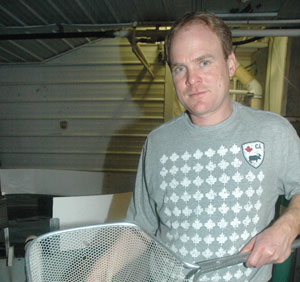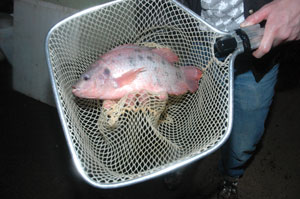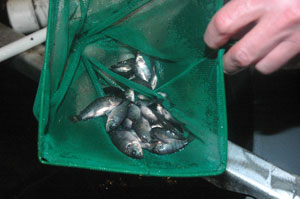


Pulling into the McNaughton family farm, one would have no idea 40,000 tilapia are thrashing around inside 31 indoor tanks being raised to go to market.
Abandoning the collapsing hog market in the late 1990’s, McNaughton converted his hog barn into a fish farm in 2001 – and since then has been shipping 60,000 live tilapia a year to Asian driven markets in Edmonton and Calgary.
“They smell better than hogs,” he laughs, happy he got out of raising pigs and has welcomed the challenges and oddities of raising these warm water fish (water temperature is kept at 27°C). “It’s a niche market compared to other food markets.”
Brought in already hatched and shipped out live when they reach the market sizes of 1.25 to 2 pounds and about 12 inches, McNaughton says immigrant consumers from Asia fuel the demand for tilapia. They are mild tasting, and are said to be "the zucchini of fish" because they soak up flavours from other ingredients when cooked. The Chinese New Year brings the biggest yearly demand, but on average 1,000 market-sized tilapia leave the farm every week.
“It works well for the farm, it’s a good sideline to grain and makes good use of the building space,” but McNaughton says it’s the mechanical side of the operation that intrigues him. “It keeps me out of trouble.”
Twenty-two 10,000 litre tanks and nine nursery tanks are used to raise the tilapia from the size of your pinkie to as big as your forearm. They come in black, white, orange, and red with the last being highly prized because some Chinese cultures believe that red brings good luck.
McNaughton is also the president of the Alberta Aquaculture Association, and says Alberta is the third largest producer of tilapia behind Toronto and Vancouver. And the market continues to grow as immigrants take up residence in Alberta. He says he’s heard some worry that the tilapia market will shrink when the first generations pass away and second and third generation Canadians stop carrying on the tradition. But now, the demand is big and with better technology being churned out always, profits can only grow, McNaughton says. Tilapia is also starting to appear in supermarkets now.
“It’s hard to find quality fish in Alberta, we’re in beef country. But the demand is always there. Fish farming worldwide is on the rise.”
They are shipped out live, saving headaches in processing and filleting the fish, which contain less meat than salmon or trout.
Indoor fish farming presents higher capital costs – mostly from heat and electricity bills, but there’s no other way to do it out on the prairies. The majority of farmed fish are raised in outdoor ponds, but he says issues arise with disturbing and manipulating the natural environment.
But it indoor farming allows him to raise tilapia all year round, and during a -15C day in February the tilapia are thrashing and feeding inside their warmed barn in near tropical temperatures. Fish farms are something he believes will continue to sprout up on the prairies as the ocean’s supply is being quickly snatched up and polluted – McNaughton says there are 11 other fish farms in Alberta.